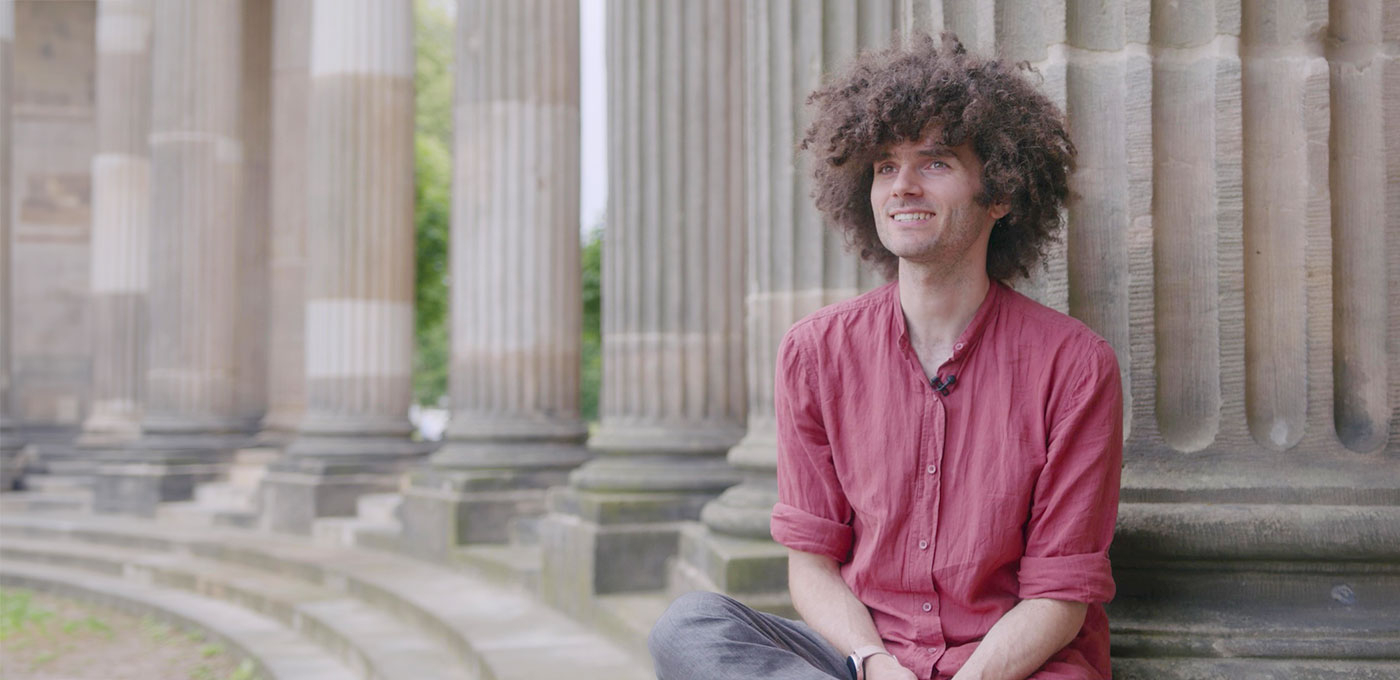
ehrenwerk.tv für VolkswagenStiftung
Perovskite pioneer: How a Freigeist Fellow is revolutionising solar cells and X-ray devices
#TransdisciplinarityPhysicist Felix Lang discovered the self-healing powers of a soft semiconductor. He now wants to use it to improve the production of electricity in space, make solar power cheaper here on Earth, and help X-rays to produce less radiation and better resolution – in colour!
"Everyone should have them, all over the world!" The so enthusiastic man with the brown shock of curly hair is called Dr Felix Lang, and he is talking about solar cells. However, the 34-year-old is not a lobbyist for the solar industry. Lang is a physicist and a Freigeist Fellow, who also leads a research group at the University of Potsdam. Together with his team, he wants to do nothing less than revolutionise the construction of solar cells used on Earth and in outer space, and bring about an improvement to medical radiology at the same time.
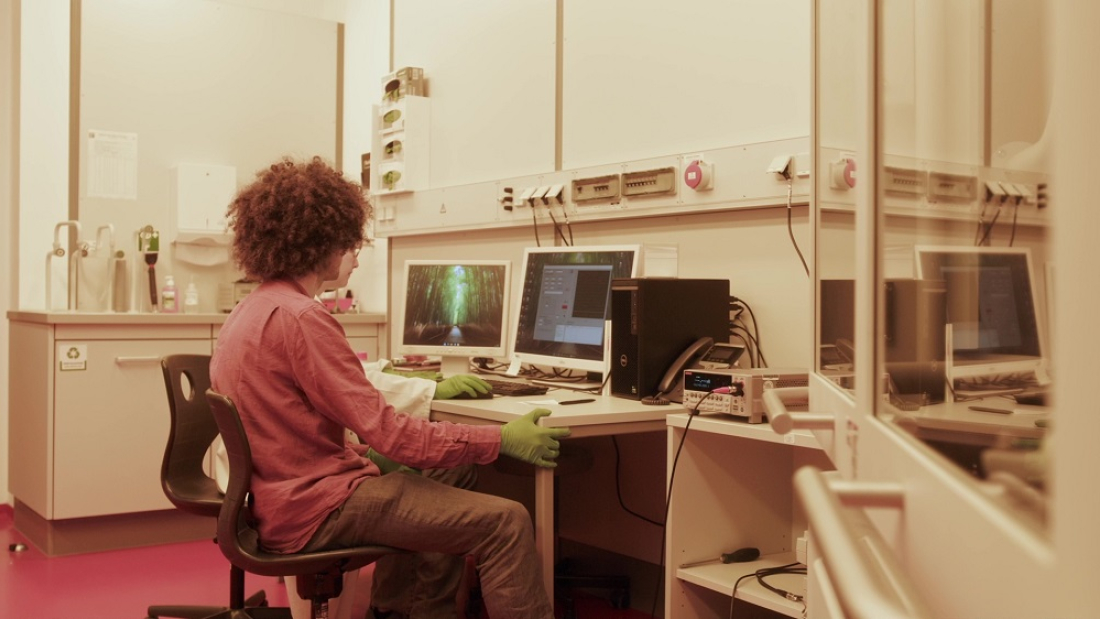
ehrenwerk.tv für VolkswagenStiftung
Felix Lang in a video portrait: Self-healing solar cells for space
Lang's interest in solar cells began at school: "I was always fascinated by solar cells because you can produce electricity yourself," the researcher recalls. He also developed a keen interest in space at an early age. "But I didn't become an astronaut because I would throw up in any form of transport," jokes Lang.
When choosing his degree programme, he hovered between physics and space technology. After all, the first solar cells were developed to provide electricity in space. Today, the International Space Station has a 200-kilowatt solar power system. The former school paramedic also briefly flirted with the subject of medicine. "In the end, I brought together all the fields that I was unable to decide between at the beginning," says Lang happily. And now he combines all three – physics, space technology and medicine – in his research.
Significant discovery – simply out of curiosity
ROSI, the name of his research group, stands for "(Radiation-) Tolerant Electronics with Soft Semiconductors". Felix Lang was already working with perovskite as a doctoral student when researchers used it to produce the first solar cells. Perovskite is the name for the comparably soft crystal structure of calcium titanium oxide, a mineral that was first discovered in the 19th century.
In 2010, researchers began to take an interest in synthetic perovskites, a promising class of semiconductors for solar cells. More out of curiosity than anything else, the always somewhat unconventional doctoral student Lang undertook an experiment at the Helmholtz Centre Berlin (HZB): How well would perovskite withstand the hard radiation in an electron accelerator?
Conventional silicon solar cells have a problem in space: when high-energy protons hit the crystal structure of the semiconductor, they knock out atoms, which then take up a different position. The crystal is no longer perfect, efficiency decreases and the solar cell breaks down over the years.
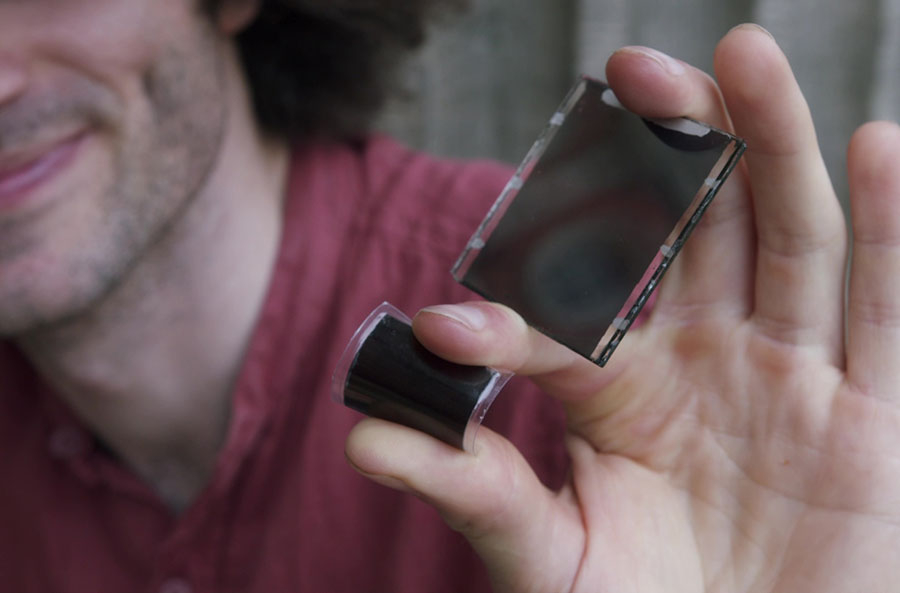
Perovskite solar cells are highly flexible.
"Perovskite, on the other hand, is soft and can heal itself," as Lang describes his observation at that time – which he was the first to publish worldwide and which would go on to shape his career. Because perovskite is so soft, atoms that have been knocked out eventually return to their original position. The researcher likes to compare this to a jelly.
Tandem solar cells for outer space
A Feodor Lynen fellowship from the Alexander von Humboldt Foundation initially enticed the young postdoc to Cambridge, where he conducted research on tandem solar cells for use in space at the Cavendish Laboratory: the combination of two layers that separately absorb different wavebands of light allows for even higher efficiencies. A return fellowship from the Alexander von Humboldt Foundation finally brought Lang back to Germany and the University of Potsdam, where a Freigeist scholarship from the Volkswagen Foundation enabled him to set up his own research group. The team's expertise is unusually wide-ranging and covers chemistry, physics, materials science and space technology.
"Even as a child, I usedto solder things together in the afternoons, and I tried my hand at inventing things too," says Lang. Sometimes things even got blown up in the process. Lang's father, an engineer by profession, gave him technology kits early on. The logical consequence was that he joined the physics club at school. He still enjoys repairing things today, especially bicycles. After all, spending time in nature, on a bike or in hiking boots, is an important balance to work. "I probably got that from my mum," says Lang, who, as a native of Munich, sometimes misses the mountains.
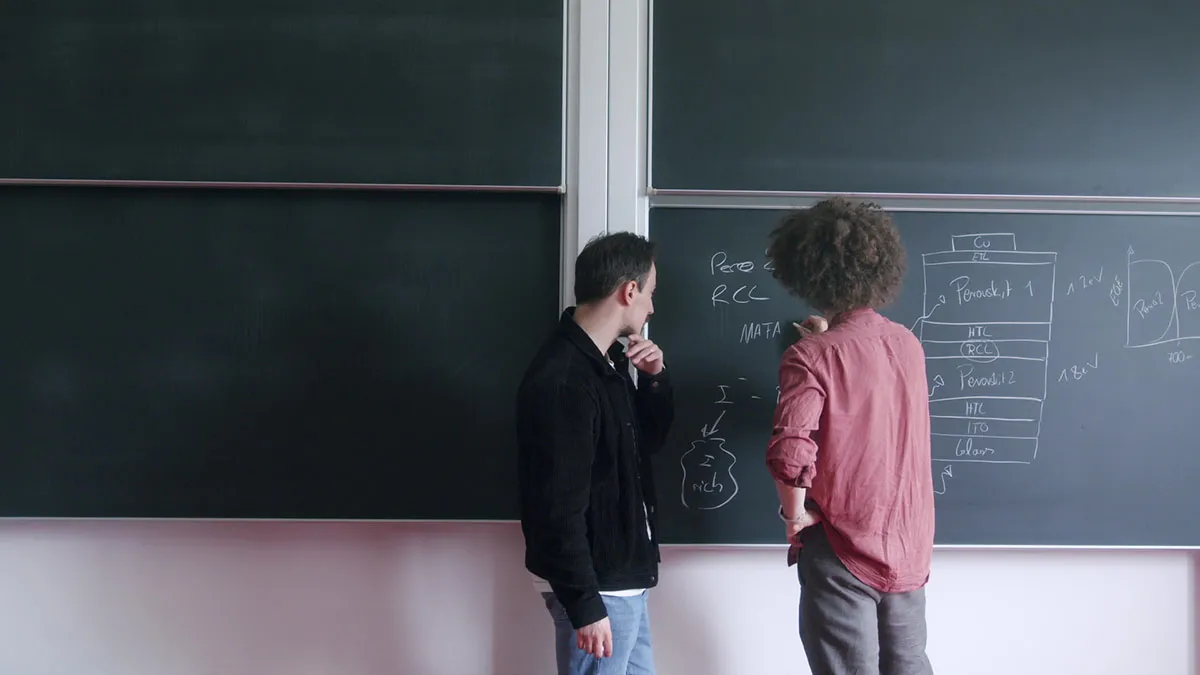
Tinkering at the blackboard: Felix Lang (right) and a colleague at the University of Potsdam.
By train and bike between work and family
The 34-year-old recently became a father himself and has little free time between work and his baby. He currently works three days a week, "but as a scientist, you don't stop at night when you are fascinated by your experimental results or failures," says Lang. He travels from his home in Berlin to work in Potsdam by train and folding bike.
Until a few years ago, the physics department at the University of Potsdam was located in Sanssouci Palace, but now the ROSI group has an open-plan office in a modern building and access to the department's laboratory wing. "The open-plan office allows for quick consultations," says Lang. If it gets too hot there in summer, the team escapes to the air-conditioned laboratories.
"The laboratories have everything we need to produce solar cells ourselves," reports the group leader. He was also able to purchase an X-ray diffractometer with the funds from the Freigeist scholarship. This allows a precise analysis of the semiconductors and a better understanding of their self-healing process. One surprising discovery, for example, is that perovskite remains stable for a particularly long time when it is irradiated and thus actively damaged.
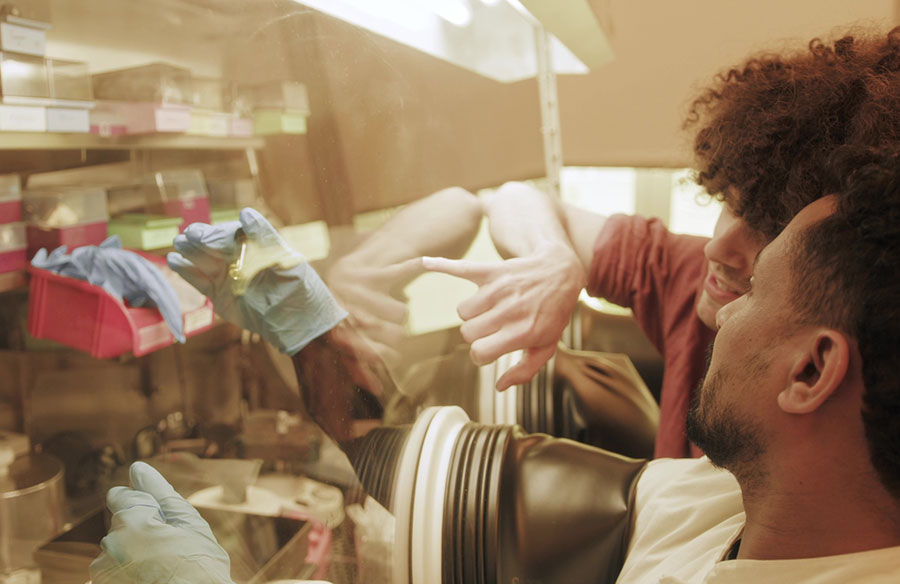
Felix Lang and PhD student Biruk Alebachew Seid prepare perovskite solution in a protected nitrogen environment.
Solar cells made from perovskite are more climate-friendly
In general, perovskite is an attractive material: it is more climate-friendly than silicon because production only requires 100 degrees instead of 1000 degrees Celsius. This also makes it cheaper. Last but not least, it "tolerates quite a lot of dirt", as Lang puts it. While silicon has to be produced in ultra-clean rooms because even a tiny impurity in the crystal damages the cells, perovskite cells even work with up to ten per cent impurities.
As in Cambridge, the ROSI group is currently focussing on tandem solar cells made from two different perovskites. "We are currently achieving up to 27 per cent efficiency on one square centimetre of surface area," reports Lang, "that is a world record and better than cells made of silicon." At the same time, initial trials are underway with three layers that absorb different parts of the light even better. The Potsdam team is also testing combinations of perovskite and silicon together with a research group at the Helmholtz Centre in Berlin led by Steve Albrecht. The record here is even 34 per cent efficiency. "But the silicon means we lose flexibility," says Lang, making it clear which way he sees the journey heading.
Electricity from space for the Earth?
Flexibility is another of perovskite's strengths. It is produced as a solution and can then be applied to any surface using rotational coating, sprayed onto a film, or printed like newsprint. "A layer just one micrometre thick can absorb 99 per cent of sunlight," explains Lang. His vision is to take films with perovskite solar cells into space and roll them out into tracks the size of football pitches. This would be unthinkable with today's silicon solar cells due to their rigidity and weight.
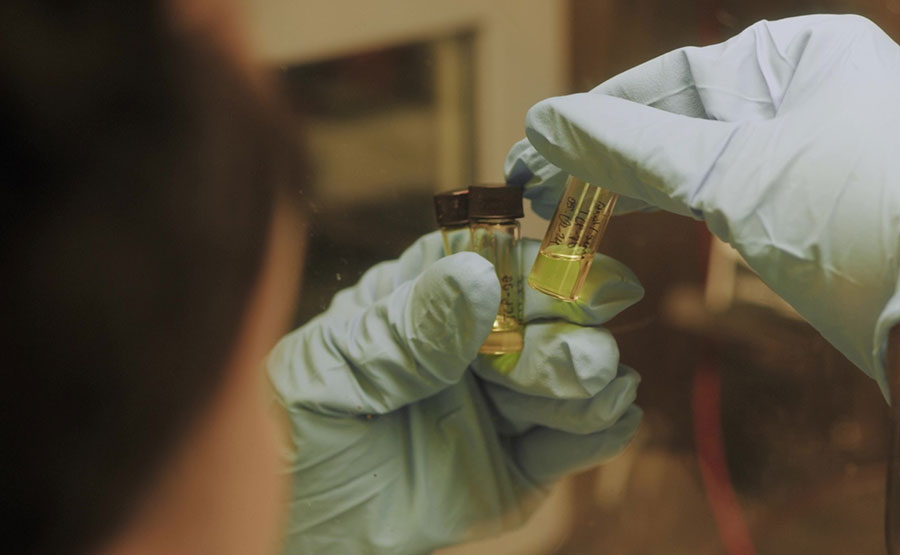
Die Perowskit-Lösung kann auf jede beliebige Oberfläche aufgetragen werden.
The electricity produced could be used to supply space stations or planetary bases – or could even be beamed back to Earth in the form of microwaves, where it could be used to generate electricity. Japan wants to utilise solar power from space on Earth as early as next year.
The physicist's visions go even further: "What if we could produce solar cells directly on the moon?" After all, one kilogramme of transport capacity into space costs around one million euros. Lang's team took regolith, a material similar to moon dust, and used it to produce a glass with perovskite solar cells. "It took a year to do it, but we are now achieving good efficiencies and converting up to ten per cent of the light energy into electricity – with a saving in weight of over 99 per cent," reports Lang.
First tests in space have begun
Just a few weeks ago, an Ariane 6 rocket was launched into space with perovskite solar cells from the ROSI Group on board. The experiment will now show whether the technology really works in space. In addition, the launch of a self-developed microsatellite with Isar-Aerospace is planned for this year, with which cells from Potsdam will be tested in space over a period of two years. "I would have liked to have been the first to launch perovskite into space," says Lang, but – due to delays in the launch of the Ariane 6 rocket – in the meantime NASA was quicker and was the first to bring perovskite films to the ISS. Be that as it may, his team will be the first to systematically test functional perovskite tandem solar cells on board a satellite in orbit – provided everything goes smoothly during the rocket launch and satellite operation.
In a further step, the ROSI group is currently testing whether organic solar cells can also be combined with perovskite. Until now, these plastic-based cells have been considered highly sensitive, but they are also relatively soft. It is still unclear whether corresponding tandem solar cells can withstand hard radiation. "We had solar cells that broke quickly and further developments – with a new additive – that were surprisingly stable," reports Lang. For the physicist, perovskite was only the first step: "We are looking for other soft, self-healing materials that don't have the weak points of perovskite." This is because the material is susceptible to humidity and oxygen, which at very least makes it difficult to use on Earth. Encapsulation between two films should protect the perovskite until such time as a more suitable alternative is found and in the long term enable cells with a shelf life of 25 years.
Lang is convinced that if perovskite proves its worth in space, it can also provide almost free solar power for Earth’s entire population, provided it is adequately protected from moisture and oxygen. "But you don't need perovskite to sensibly tackle climate change," emphasises the researcher, who is focused on sustainability and climate protection. "If we want to produce green electricity as quickly as possible, we don't have to wait: we already have a great solution with silicon – that we can later expand with perovskite."
Low-radiation X-ray in colour?
However, Lang is convinced that perovskite could also be put to good use elsewhere and has therefore set another focus for his team: in medicine. "Modern X-rays have a good resolution, but it could be better and the radiation exposure lower if the detector were more sensitive," explains the physicist. In his opinion, perovskite would be perfect: "It can withstand radiation, doesn't break down, and contains relatively heavy elements." The team has already overcome the first hurdles, such as the fact that a fairly thick layer is required to absorb X-rays. "In some cases, we are already getting better results than the medical detectors used in hospitals," says Lang, not without pride. He could imagine that one day every operating table will have a built in X-ray function that will be able to produce images in colour.
Although Lang gives his group members, who clearly think a lot of him, the freedom of scope to make decisions, his own laboratory work sometimes comes up short alongside the organisational tasks. "We recently had a measurement session at the Berlin Synchroton Bessy II and the experiment was more difficult than expected," says Lang. He and his team improvised together for two days and eventually saved the experiment. "It's fun being on site in the lab and getting things to work with adhesive tape, aluminium foil and soldering irons," says the physicist happily.
In general, Lang finds creativity important: "It's difficult to compete with the really big groups in China and the US. That's why we look for unconventional approaches to be able to play in the upper league, and that works quite well," emphasises the researcher. "We don't have the team size to try out 100,000 variants, but we do have good analytics and good ideas. We build a component, be it a solar cell or detector, try to understand the cause of any remaining inefficiencies, and then make it better."


